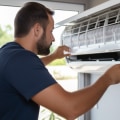Spun fiberglass is an affordable and reliable resource for filtering air and trapping contaminants. Fibreglass is great for trapping large contaminants, such as dust and pet dander, and often helps maintain superior airflow. Many high-efficiency air filters are made primarily of fiberglass. To measure filter efficiency, experts use the minimum efficiency notification value (MERV).
The MERV is a graph that classifies filters according to their ability to capture particles. The rating ranges from 1 to 16, and 16 are awarded to the types of air filters with the best filtering capacity. The MERV ratings for the different types of filters vary depending on their quality and manufacturer. It's always mentioned on the package. Despite their popularity, these filters do not contribute much to indoor air quality.
They can only filter about 20% of particles that are between 3.0 and 10.0 microns in size. Particles of this size only include dust, carpet fibers and pollen. Pleated filters are similar to fiberglass air filters. However, they usually use polyester fabric to perform the filtration.
They are also better able to prevent dust from entering a room. This air conditioning filter material has an accordion-like shape, providing pleated filters with a larger filtration surface than flat filters. The surface area also offers less resistance to airflow and makes the filters last longer. The company that also manufactured its air conditioning unit manufactures an OEM furnace filter, while the air filters in the aftermarket are manufactured by specialized external companies. While the options may seem daunting, choosing the best air filter is simple if you understand a few key factors.
Using wet filters can cause mold and bacteria to accumulate, which will reduce indoor air quality. Some people need filters for the air conditioning system to keep the air free of allergens and other contaminants, while others only need a basic filter to do their job. Dirt that enters through the vents surrounding a filter can also damage the air conditioning system and cause a system failure that could cost hundreds of dollars in repair costs. When it comes to air filters for air conditioning systems, multimedia filters can offer more advantages than standard filters with high MERV ratings. These filters aren't known for improving air quality, as they don't try too hard and can only trap some of the dust and allergens. Understanding the different types of air filters for homes is essential for ensuring optimal indoor air quality and comfort levels.
Selecting the right combination of air filter material depends on airflow restrictions, retention efficiency requirements, application environment, and budget parameters. While some types of air filters come with reusable and disposable options, washable filters are an environmentally friendly way to save money. Because of the high efficiency of these filters, they are popular with people who are allergic to air conditioning or other respiratory problems. Second, while UV light filters remove bacteria and viruses from the air, they don't work very well against contaminants such as dust. Multimedia filters provide the same level of filtration as a filter with a high MerV content, but they do so without the negative consequences of airflow or static pressure. When looking for the best air filter for your home, you'll have to choose between different air conditioner filter materials.
The starting price of this type of air filter for air conditioning systems is high, but it must be considered an investment that will last for many years. When selecting an air filter material for your home's HVAC system, it's important to consider factors such as MERV rating, cost-effectiveness, durability, and ease of maintenance. Fiberglass is an affordable option that offers good filtration capabilities but may not be suitable for those with allergies or asthma due to its inability to capture smaller particles. Pleated polyester fabric is another popular choice due to its ability to capture smaller particles than fiberglass while still providing good airflow resistance. Multimedia filters offer superior filtration capabilities without sacrificing airflow or static pressure. Finally, UV light filters are great for removing bacteria and viruses from your home's air but may not be effective against larger particles such as dust or pet dander. Choosing the right material for your home's HVAC system is essential for ensuring optimal indoor air quality and comfort levels. Consider all factors before making your decision so you can enjoy clean and healthy indoor air.



